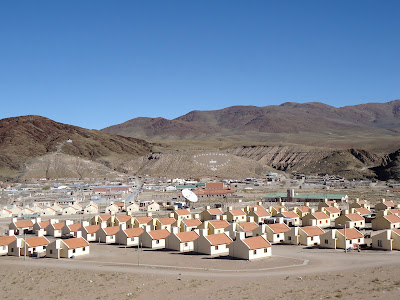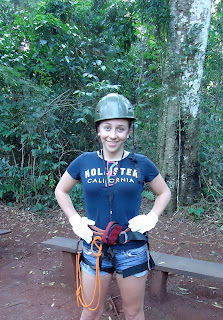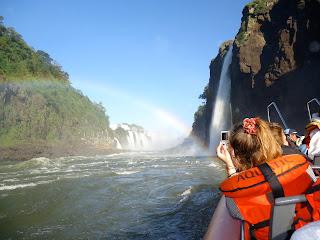The material used to build this bridge was imported from Europe and is also the same material used to build the Eiffel Tower. It is part of the Train to the Clouds rail tour.
Through out the day we climbed up to altitudes as large as 4,200 meters above sea level which meant the higher we went, the colder it got, especially at the crack of dawn. Our second picture taking stop was breath taking and beautiful as well as freezing.
Our next stop was in a little town called Santa Rosa de Tastil. It is one of the most important pre-Inca sites in the region, it has interesting ruins and a site museum. Nearly 5,000 stones scattered on a hill nearby bear petroglyphs that the indigenous population carved to convey religious and magical concepts. Some stones bear supplications of Inca gods, others just figures of animals and humans. In pre-Hispanic times, the town functioned as the main regional trade center.
We found petroglyphs painted on the side of the museum to show how important they are to this town and its history.
Inside the museum we found a mummy that was discovered nearby...
And more petroglyphs. These painting are copies of petroglyphs set on the stones on the nearby hill.
After exploring the museum we got back on the bus and headed to our next stop. Along the way we had a scenic route with snow cover mountains and views of volcanos.
Next stop was a small city called San Antonio de los Cobres. The main claim to fame of this high-altitude city (3,774 meters above sea level) is being a stop on the Train to the Clouds.
After our lunch in San Antonio de los Cobres, we started the rest of the drive to Las Salinas Grandes. The route from San Antonio de los Cobres to Las Salinas Grandes is about 3 hours on a dirt road, where we found herds of llama and vicuñas. Vicuñas are the worlds smallest camelids, they are wild and very wary of humans. Their fine-quality wool is priced in northern Argentina, and they were almost hunted into extinction. We are lucky to be able to see them now thanks to the help of breading farms that have kept their species alive all of these years.
Its hard to find them in the distance for their sandy color blends in to the landscape.
And finally what we had all been waiting for, Las Salnas Grandes!!!!! :D
It's not snow, it's Salt!!!
The white "soil" that adds a new color to the dry northern landscape is salt produced by the evaporation of saline water of volcanic origin.
The long white plane allowed us to take creative pictures like this one. It makes someone kicking a group of people or holding a tiny person seam real.
We had a great group on this trip. As always, traveling with AFS students is amazing and super fun. [From top left, Sophie from Austria, Laura from Switzerland, Andy from Italy, ME, from bottom left, Tyler from USA, Valerie from Salta, Alicia from Germany, Ruben our Salta volunteer and friend who also helped organize the trip, and Tan from Thailand.]
After the Salt Flats we picked up National Route 52 (famously known as Cuesta de Lipan), which links Purmamarca with the Salinas Grandes salt flats. The route snakes it way up the mountain road which offers a spectacular view of the valley below and the salt flats in the distance. The road makes a climb up to 4,170 meters above sea level.
^A beautiful picture of the Argentinean flag in the plaza looked over by the multicolored hills in the background.
Our day started at 7am and we got back to Salta around 8:30pm. It was a long day but completely worth it. Trips like these remind me of what made me decide to do a year abroad in the first place. My first love has always been travel. I love seeing new places, being introduced to new cultures, and learning about the history and qualities that make every different place unique. I have been living in Argentina for 9 months now and it escapes me at how fast my time has gone by. I have less than 8 weeks left in Argentina and I am planning on making the most of every second I have left.
As always, Thank you for reading!




































